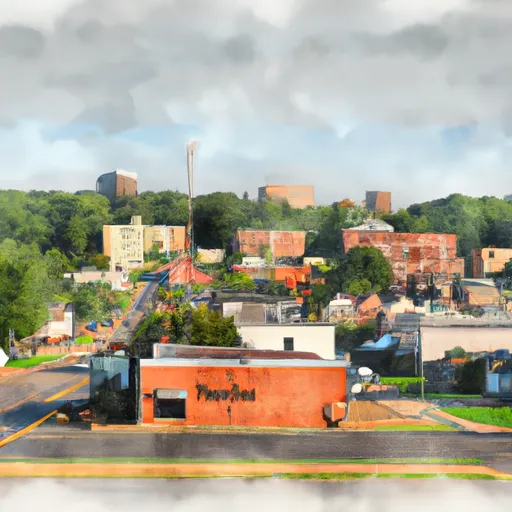-
 Snoflo Premium
Snoflo Premium
Get unlimited access to all our content
With no Ad interruptions! - Start Your Free Trial Login with existing account
Wickes
Eden Index
Climate
7.5
•
Recreation
3.2
•
Community
0.6
•
Safeguard
4.3/10

Wickes, Arkansas is a small town located in Polk County, nestled in the scenic Ouachita Mountains. The climate in Wickes is categorized as humid subtropical, with hot summers and mild winters. Summers are typically warm and humid, with temperatures averaging in the high 80s°F (around 30°C), while winters are generally mild with temperatures averaging in the 40s°F (around 5°C).
The town is abundant in natural beauty, with the Cossatot River flowing nearby. The river is known for its pristine waters and is a popular spot for various recreational activities, including fishing, kayaking, and canoeing. Wickes is also surrounded by the Ouachita National Forest, offering numerous opportunities for outdoor enthusiasts. Hiking and camping are popular activities in the area, with several trails and campgrounds available for exploration.
The hydrology constituents in Wickes are primarily focused around the Cossatot River. The river is home to various species of fish, including smallmouth bass, largemouth bass, and catfish, making it a fantastic destination for anglers. The river's clear waters and challenging rapids also attract whitewater rafting enthusiasts.
Overall, Wickes, Arkansas offers a delightful climate, stunning landscapes, and ample opportunities for outdoor recreation, making it an ideal destination for nature lovers and adventure seekers alike.
What is the Eden Index?
The Snoflo Eden Index serves as a comprehensive rating system for regions, evaluating their desirability through a holistic assessment of climate health, outdoor recreation opportunities, and natural disaster risk, acknowledging the profound impact of these factors on livability and well-being.
Climate Health Indicator (CHI): 7.5
Wickes receives approximately
1431mm of rain per year,
with humidity levels near 80%
and air temperatures averaging around
16°C.
Wickes has a plant hardyness factor of
7, meaning
plants and agriculture in this region tend to thrive during the non-winter months.
By considering the ideal temperature range, reliable water supplies, clean air, and stable seasonal rain or snowpacks, the Climate Health Indicator (CHI) underscores the significance of a healthy climate as the foundation for quality living.
A healthy climate is paramount for ensuring a high quality of life and livability in a region, fostering both physical well-being and environmental harmony. This can be characterized by ideal temperatures, reliable access to water supplies, clean air, and consistent seasonal rain or snowpacks.
Weather Forecast
Streamflow Conditions
Red-Little
Area Rivers
Red-Little
Snowpack Depths
Red-Little
Reservoir Storage Capacity
Red-Little
Groundwater Levels
Recreational Opportunity Index (ROI): 3.2
The Recreational Opportunity Index (ROI) recognizes the value of outdoor recreational options, such as parks, hiking trails, camping sites, and fishing spots, while acknowledging that climate plays a pivotal role in ensuring the comfort and consistency of these experiences.
Access to outdoor recreational opportunities, encompassing activities such as parks, hiking, camping, and fishing, is crucial for overall well-being, and the climate plays a pivotal role in enabling and enhancing these experiences, ensuring that individuals can engage in nature-based activities comfortably and consistently.
Camping Areas
| Campground | Campsites | Reservations | Toilets | Showers | Elevation |
|---|---|---|---|---|---|
| Hurricane Creek - Lake of the Pines | 23 | 226 ft | |||
| Buckhorn Creek - Lake Of The Pines | 60 | 283 ft | |||
| Martin Creek Lake State Park | 93 | 347 ft | |||
| Jackson Creek Park - Lake Texarkana | None | 327 ft | |||
| Caddo Lake State Park | 28 | 281 ft | |||
| Brushy Creek - Lake Of The Pines | 60 | 290 ft | |||
| Tinkle Park - Lake Murvaul | None | 275 ft | |||
| Rosie Jones Park - Lake Murvaul | None | 286 ft | |||
| Atlanta State Park | 60 | 286 ft | |||
| Johnson Creek - Lake Of The Pines | 95 | 280 ft |
Nearby Ski Areas
Catastrophe Safeguard Index (CSI):
The Catastrophe Safeguard Index (CSI) recognizes that natural disaster risk, encompassing floods, fires, hurricanes, and tornadoes, can drastically affect safety and the overall appeal of an area.
The level of natural disaster risk in a region significantly affects safety and the overall livability, with climate change amplifying these risks by potentially increasing the frequency and intensity of events like floods, fires, hurricanes, and tornadoes, thereby posing substantial challenges to community resilience and well-being.
Community Resilience Indicator (CRI): 0.6
The Community Resilience Indicator (CRI) recognizes that education, healthcare, and socioeconomics are crucial to the well-being of a region. The CRI acknowledges the profound impact of these elements on residents' overall quality of life. By evaluating educational resources, healthcare accessibility, and economic inclusivity, the index captures the essential aspects that contribute to a thriving community, fostering resident satisfaction, equity, and social cohesion.

